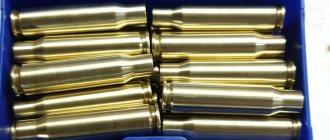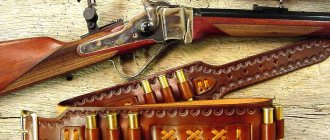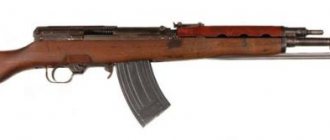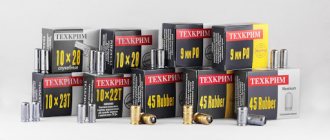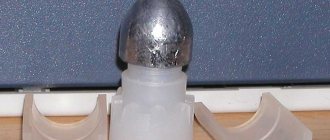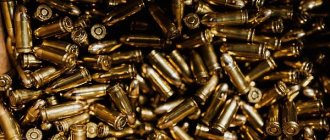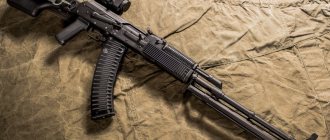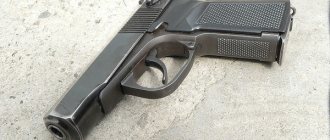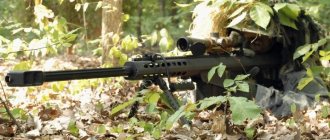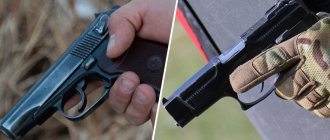There are a lot of options for loading buckshot cartridges; I will share my method of loading 12-gauge cartridges with buckshot.
Nowadays there are a lot of factory-made cartridges for sale for every taste, but these cartridges are good for amateur hunters; real professionals load the cartridges themselves, taking into account the features of their gun. If a cartridge can be loaded with a simple shot very simply without any extra tricks, then a buckshot cartridge should have good accuracy and consistency of fire, since there is not so much buckshot in the cartridge.
I’ll show you two ways to load 12-gauge cartridges with 8mm buckshot; this buckshot is quite large, which makes it possible to shoot a large wild boar for sure, not to mention smaller game.
These buckshot cartridges are perfect for a regular hunting rifle, which have choke and choke choke constrictions; I shoot from an old IZH 58m gun, below is a photo of shooting buckshot cartridges equipped with my method.
I love cartridges, as I call them with a surprise or with buckshot of luck, this will be the first option for loading a cartridge with buckshot. The essence of this cartridge is that it contains 11 8mm buckshots. three buckshots go straight to the target and the rest have a wide spread. Many will ask the question why such a cartridge is needed, I will answer, if you have to shoot at a short distance at a running game and there is always a chance of a little smearing, so the buckshot of luck can injure or kill the game, depending on where it hits. And if the cartridge hits very closely, then at the moment of a small miss, all the buckshot will pass by. But if you hit it accurately with this cartridge, then three powerful buckshots will fall very closely, and this may be enough even for a large boar.
The second method of loading a buckshot cartridge consists of 9 8mm buckshot shells, this cartridge without buckshot shells is lucky, the buckshot goes very well, this cartridge is good for finishing off a wounded animal for sure. Or with good aiming over a long distance.
I believe that effective shooting from a standard gun is always up to 50m, anything beyond that is more often luck or a wounded person. Therefore, you shouldn’t think too much that a standard shotgun is capable of very long distances, thereby getting into your head and thinking that there’s something wrong with the gun; for long distances you need a rifled carbine.
Photo. Sawdust, cartridges, buckshot, powder measure, sunar magnum powder.
The first method of loading buckshot cartridges, with buckshot of luck
To equip a buckshot cartridge with a surprise, you will need sawdust. I will equip it with Sunar Magnum gunpowder, but you can also equip it with other gunpowder, falcon is great. I measure the gunpowder with a yardstick, since I’m too lazy to weigh it all the time. It’s advisable to make the yardstick from a 410 caliber cartridge case, since it gives very accurate portions of gunpowder, but each gunpowder must have its own measure, since the volume and weight of each gunpowder is different. My favorite powder weight is 2g, although the recommended powder weight for Sunar Magnum is 2.1g. I always proceed from the fact that less and more reliable is better than more and more dangerous.
Having made a measurement for 2g of gunpowder, you can no longer be afraid; if you take a little more with the measure, do not go beyond the permissible limits, and the weight of the shot or buckshot is always a little less, firstly, this gives greater sharpness of the battle, and once again does not strain the gun.
Photo. Loading a grapeshot cartridge filled with sawdust.
Now the essence of equipping a buckshot cartridge with buckshot of luck.
It’s good that you can use both iron and plastic cartridges, the impact of the buckshot is the same. They hammered the primer, poured gunpowder, and placed a thin paper gasket on the gunpowder.
And now here’s the trick to equipping a buckshot cartridge with good luck buckshots.
Photo. A loaded cartridge with buckshot of luck.
Fill up a full sleeve of sawdust, place four 8mm buckshots on the sawdust, push the buckshot with sawdust all the way, fill the full sleeve of sawdust again, place four more 8mm buckshots, again push the buckshot until it stops, again pour sawdust along the edge of the sleeve, insert three buckshots, push it with a forceps until stop, on top there is more sawdust along the edge of the sleeve, put a katon gasket and tighten the cartridge, and fill the iron one with paraffin.
Photo. Shot of a grapeshot cartridge with buckshot of luck, pay from the barrel.
The weight of 11 eight-millimeter buckshots is 33.5 g, which does not strain the gun and gives good combat sharpness.
The photo shows the shooting of cartridges with buckshot of luck from a distance of about 30-35 meters, as you can see, three buckshots lie clearly on the target, the distance between them is about 10-15 centimeters, the rest of the buckshots flew away for luck. So these three buckshots are quite enough to hit the animal well at the slaughter site.
Photo. Shot of a grapeshot cartridge with buckshot of luck, choke from the barrel.
20 gauge buckshot
Twenty gauge, or twenty. How many controversies and legends surround guns of this caliber! The owners of 16 and 12 gauges provide a lot of arguments in favor of their powerful calibers. At the same time, owners of twenty rifles do not want to hear about increasing the caliber of their guns, defending the merits of their favorites.
Which one is right? And those and others. On the one hand, the twenty is rather weak when hunting dangerous and massive animals. But it is indispensable for running hunts due to its low weight.
The thing is that the stopping effect of such a projectile is much less than that of the mentioned calibers. This is due to both the mass and diameter of the bullets. In addition, the number of buckshot or pellets in the projectile is significantly less.
20 gauge buckshot above 7 millimeters , since the internal diameter of the bore is 15.6 millimeters.
This means that when passing through the barrels, the largest buckshot projectile will be subject to severe deformation, and the barrels will be very loaded - it will not even pass through the barrel unless it is arranged in a column, one piece in a row.
And then the height of such a column naturally increases. Because of this, sometimes it is necessary to reduce the thickness of the wads in order to roll the cartridge. And this can lead to the breakthrough of gases into the projectile and a decrease in the accuracy of fire.
It often happens that it is more profitable to take smaller number of buckshot. Then the number of balls that hit the target increases.
Suitably sized, matched 20-gauge buckshot reliably hits targets at a distance of up to 35 meters. Especially high quality - clad.
When loading such cartridges at home, you have to wrap a column of buckshot in paper, sometimes with a spacer of wooden sticks that center the buckshot in the case and barrel. It is much more convenient to take ready-made cartridges that use a polyethylene concentrator cup. It also performs the functions of a wad.
Speaking about the twentieth caliber, it is worth noting that the starting speeds of buckshot, shot or bullet shells in these guns are somewhat higher. This makes a positive amendment to shooting with cartridges of this caliber.
When hunting wolves, shooting gilts or roe deer, this gun is quite acceptable - the energy of the projectile and its penetrating ability are quite high.
Having loaded hunting buckshot cartridges, you should remember that this is still not a bullet fired from a gun of the same caliber, and its stopping effect is less when it comes to a powerful cleaver, bear, or elk at a considerable distance.
But when shooting close, the buckshot cartridge is simply magnificent. Such a projectile has a tremendous shocking effect and produces a remarkable result when it hits.
But you shouldn’t get carried away with shooting a 20-gauge elk, a cleaver or a large bear. Such hunting is accompanied by serious risk due to the low lateral load of the projectile, which is determined by the ratio of the mass to the area of its cross-section. The affected area, the depth of penetration of bullets or buckshot, their mass - these are the main indicators that must be taken into account first of all when choosing the type and size of game.
When shooting at an animal such as a wolf, saiga and the like, you should load hunting buckshot into the cartridges, which will do an excellent job of putting the animal down securely.
And here the twentieth caliber will be effective, especially if you need to stand in ambush for a long time, when the gun is constantly in your hands - the low weight will keep your hands ready for a quick jump and shot.
Thus, by approaching the use of twenty gauge wisely, you can get excellent results.
I would like to add that 20-gauge cartridges are much more economical than 12-gauge cartridges - the consumption of both gunpowder and shot or buckshot is much less.
Loading a grape cartridge for high-accuracy shooting
The principle of equipping a buckshot cartridge for mass shooting is exactly the same as described above, but it requires only 9 8mm buckshot shells, the buckshot shells are stacked in threes, also in the rows described above. Below are photos of shooting such cartridges into trees from a distance of 30-35 meters, as you can see there is good accuracy for a buckshot cartridge; with good aiming, all the buckshots will hit big game.
Photo. Holes of a bunch of grapeshot cartridges from payday.
Someone will have a question why such methods of equipment give such a fight, I can’t say for sure, all this equipment was tried in different versions. But I can assume that the sawdust provides a kind of container for buckshot, the buckshot does not touch each other, thereby deforming less, three buckshots in a row fit well in the barrel, four are slightly deformed, which causes them to deviate from the straight trajectory of the shot.
Photo. Holes of a bunch of buckshot cartridges from a choke.
The shooting was carried out at the Ash tree, it is very strong; it is impossible to drive a nail into it, but all the buckshots went very deep into the tree, which indicates good sharpness of the battle, which means they will hit the animal very well.
What I like about equipping these buckshot cartridges is that they give a very constant fight, without throwing out surprises when all the buckshot can scatter in different directions and not one of them will hit the target. These cartridges, with their accuracy, make it possible to hit small game, such as a hare, not to mention a larger animal.
This method of loading a buckshot cartridge is suitable for buckshot of any diameter; if you lay buckshot of a smaller diameter, taking into account its consistency in the barrel, thanks to the sawdust, you can create layers of buckshot that do not touch each other, you can achieve different accuracy. You can also use a container; the container is inserted onto the gunpowder, and then the buckshot is placed in the described manner in layers and sprinkled with sawdust. As you can see, to select the right cartridge and the required accuracy, you can experiment as you like, but do not go beyond the permissible weights of gunpowder and buckshot. I hope my experience will be useful to novice hunters, since by loading cartridges taking into account the characteristics of your gun, you can achieve good shot performance in both sharpness and accuracy, but any loaded cartridge must be shot at the target to be sure that you have achieved what you were aiming for.
What’s interesting is that the guns are all the same in concept, but each has its own fire, the same cartridge in different guns will give its own accuracy, but by empirically selecting the cartridge’s equipment, you can improve the accuracy of even an unimportant gun.
Therefore, a factory cartridge will always give average performance, and a cartridge selected experimentally for a specific gun will give excellent accuracy and sharpness of the fight, without tearing the gun and not giving strong recoil, knocking off the hunter’s shoulder.
2.3.4. Loading cartridges with large shot and buckshot
2.3.4. Loading cartridges with large shot and buckshot
Wolf, roe deer, and saiga are shot with grapeshot;
Buckshot is also used for hunting lynx, musk deer, and small boar at a distance of 35–40 m, rarely further. It should be noted that grapeshot shooting in hunting aims to more reliably hit a relatively large animal due to a larger number of damaging elements than is available when shooting with a single bullet.
For shooting wolves from 12-gauge shotguns with chokes, a cartridge loaded with small (5.8 mm in diameter) matched buckshot has long been used; the projectile consists of 28 buckshots (4 rows of 7 buckshots each) with a total weight of 33 g. The projectile is placed in a cup (or ring) made of paper (or plastic film). For wild boar hunting, larger buckshot is used, with a diameter of 8–8.5 mm; For a 12-gauge shotgun shell, there are 9 buckshots (3 rows of 3 buckshots each).
Hunting stores receive not only buckshot, but also factory cartridges loaded with buckshot. Shooting ready-made cartridges with large buckshot (3 rows of 3 buckshot in each row), laid out in the most primitive way (the upper buckshots lie in the spaces between the lower ones), gave good results: at 35 m the entire projectile was placed in a circle of 59–77 cm, the pressure was normal. However, keep in mind that factory cartridges are fired from a 0.5mm ballistic barrel, and there is no way to tell what the results will be when fired from a 1mm barrel. Therefore, you should load your own shotgun cartridges yourself.
Loading buckshot cartridges and zeroing a gun with buckshot require certain knowledge, skills, and experience. Without exaggerating, we can say that our hunters have deliberately shot a smaller portion of their guns with buckshot. Meanwhile, a grapeshot shot is always responsible, therefore both the equipping of grapeshot cartridges and the shooting of a gun with them must be taken with complete seriousness.
For shooting with buckshot, new folder casings are used, since with thin-walled metal casings not only the combat worsens, but there is a risk of swelling of the barrels, and plastic casings are not reliable in winter.
Loading cartridges with large shot and buckshot has its own characteristics and imposes special requirements. It is impossible to simply pour buckshot and large shot into the cartridge case, like ordinary shot No. 2-10, since some buckshot and large pellets fall into the recesses between other underlying ones, and when fired, they become wedged and deformed, which leads to the dispersion of the projectile when it leaves barrel, reduces accuracy and sharpness, and in some cases - to a strong blow before the muzzle narrowing and rupture of the barrel. Therefore, the size of the buckshot is coordinated with the bore, if it is cylindrical, or with a muzzle constriction. To reduce the wedging effect, the projectile is usually filled with starch or talc, or the projectile is loaded into a container. There is also a combination of two methods, as well as connecting buckshots with a thread or rod.
Buckshot can be consistent or inconsistent. Matched buckshot is one that is selected so that when one layer is laid in the muzzle there are no gaps between the buckshot and the walls of the barrel. Matched buckshot is selected as follows. From the side of the chamber into the barrel with the greatest choke (it is possible, and even better, to load cartridges separately for each barrel, but this is impractical, and during hunting they can easily be confused), a wad is sent with a ramrod, which should not reach the muzzle by about one diameter of stacked buckshot. On this wad there is one layer of buckshot of the selected diameter. Buckshot is selected of such a size that it fits in the muzzle constriction in a continuous row without gaps, but at the same time without deformation. If it is placed freely, it is necessary to slightly increase the diameter of the buckshot, and if it is very tight or the last buckshot does not fit, then the diameter of the buckshot should be reduced.
The number of buckshots in a row can be 3, 4, 5 and 7 ( Table 27
). With a smaller or larger number, the stability of the charge is violated. As stated in the Hunting Ammo section; the dimensions of the matched buckshot for each gun can be determined using the following formulas: d3=0.46D; d4=0.41D; d5=0.37D; d7=0.33D, where D is the diameter of the muzzle. These formulas are suitable for guns of any caliber.
You can select matched buckshot in a different way. Measure the exact diameter of the choke of the left (upper) barrel and, using the table. 27
, determine the diameter of the matched buckshot.
For example, if you have a 12-gauge shotgun with a muzzle diameter of the upper barrel of 17.6 mm and you are going to shoot a wolf, for which buckshot with a diameter of approximately 6 mm is recommended, then looking at the table.
27 , you see that for a choke of 17.6 mm (when laying 7 buckshots in a row), the diameter of the matched buckshot should be 5.86 mm. The domestic industry produces two sizes of buckshot close to the size of 5.86 mm: 5.80 and 5.90 mm. To get good results when shooting, it is better to use less dense packing of buckshot. This means that you should choose a buckshot diameter of 5.80 mm. There are three main ways to place buckshot in a cartridge case:
Table 27
Matched Buckshot
| Choke diameter, mm | Number of buckshots in a row, pcs. | |||
| 3 | 4 | 5 | 6 | |
| diameter of matched buckshot, mm | ||||
| 12,2 | 5,70 | 5,05 | 4,43 | 4,06 |
| 12,4 | 5,81 | 5,15 | 4,50 | 4,13 |
| 12,6 | 5,90 | 5,22 | 4,57 | 4,20 |
| 12,8 | 6,00 | 5,31 | 4,65 | 4,27 |
| 13 | 6,09 | 5,38 | 4,72 | 4,33 |
| 13,2 | 6,17 | 5,49 | 4,79 | 4,40 |
| 13,4 | 6,27 | 5,56 | 4,86 | 4,47 |
| 13,6 | 6,38 | 5,64 | 4,93 | 4,53 |
| 13,8 | 6,45 | 5,72 | 5,00 | 4,60 |
| 14 | 6,55 | 5,80 | 5,08 | 4,67 |
| 14,2 | 6,62 | 5,88 | 5,14 | 4,73 |
| 14,4 | 6,74 | 5,97 | 5,23 | 4,80 |
| 14,6 | 6,83 | 6,05 | 5,29 | 4,87 |
| 14,8 | 6,91 | 6,13 | 5,37 | 4,93 |
| 15 | 7,01 | 6,22 | 5,42 | 5,00 |
| 15,2 | 7,11 | 6,30 | 5,51 | 5,07 |
| 15,4 | 7,20 | 6,38 | 5,58 | 5,13 |
| 15,6 | 7,30 | 6,48 | 5,66 | 5,20 |
| 15,8 | 7,38 | 6,56 | 5,74 | 5,27 |
| 16 | 7,48 | 6,62 | 5,80 | 5,33 |
| 16,2 | 7,57 | 6,71 | 5,87 | 5,40 |
| 16,4 | 7,68 | 6,80 | 5,94 | 5,46 |
| 16,6 | 7,76 | 6,89 | 6,02 | 5,53 |
| 16,8 | 7,87 | 6,98 | 6,10 | 5,59 |
| 17 | 7,97 | 7,03 | 6,16 | 5,66 |
| 17,2 | 8,04 | 7,11 | 6,24 | 5,73 |
| 17,4 | 8,14 | 7,21 | 6,30 | 5,80 |
| 17,6 | 8,22 | 7,30 | 6,38 | 5,86 |
| 17,8 | 8,32 | 7,39 | 6,46 | 5,93 |
| 18 | 8,41 | 7,46 | 6,52 | 6,00 |
| 18,2 | 8,50 | 7,52 | 6,59 | 6,07 |
| 18,4 | 8,60 | 7,62 | 6,67 | 6,13 |
| 18,6 | 8,70 | 7,70 | 6,75 | 6,20 |
1) The usual laying of matched buckshot directly into the sleeve, with the buckshot of the top row located in the spaces between the buckshot of the bottom row, and the central buckshot with 5 and 7 pieces in a row lies above the rest or is removed. Used in cylindrical drill barrels;
2) Laying buckshot in a column, when the buckshots of the top row are not located in the spaces between the buckshots of the bottom row, but one above the other. Matches or polyethylene inserts are placed in the spaces between the buckshot and the wall of the cartridge case. It is used in both barrels with cylindrical and choke drilling, in the latter case some kind of containers are used;
3) Packing buckshot into containers, including wrapping the projectile with paper, plastic film, etc. Used for barrels with all types of narrowings. For cylinders - in cases where the diameter of the buckshot is smaller or larger than the matched one, for barrels with choke constrictions - both when using unmatched and matched buckshot. In the latter case, methods of artificial matching of buckshot are used.
After determining the size of the buckshot approved for your gun, you should shoot the gun, choosing the optimal ratio between the masses of the powder charge and the buckshot.
The best fighting with buckshot is given by cylindrical barrels, since their diameters of the bore along the entire length and the cartridge cases are almost the same. But if the buckshot is not coordinated and is not laid in rows of 3, 4, 5 or 7 pieces, then the accuracy of the battle will be very low.
Typically, the impact of a cylindrical barrel is considered satisfactory with an accuracy of 40–50%. By using a thin paper container with a slightly reduced diameter of buckshot (the buckshot is adjusted not to the diameter of the barrel, but to the diameter of the barrel minus the double thickness of the paper container), you can increase the accuracy of the fire by 12–15%.
When shooting shotguns with choke constrictions, it is necessary to match the diameter of the buckshot with the diameter of the choke constriction, and not with the diameter of the bore or cartridge case. If this is not done, then with strong chokes the result will be a very bad and inconsistent fight. The fact is that buckshot, coordinated with the bore and laid in correct rows, begins to rearrange and deform when passing the choke (it can even damage the choke). This results in poor and inconsistent combat. It is desirable that the buckshot is tightly located in the choke, 3, 4, 5 or 7 pieces each, and in the case it will naturally be located with gaps between the buckshot. Therefore, the most rational equipment for buckshot cartridges for a choke should be considered matched buckshot, stacked in a column, sprinkled with potato flour. In this case, the weight of the starch should be included in the weight of the projectile. Approximately one charge of 12-gauge requires 3 g of starch, 16-gauge - 2.5 g, 20-gauge - 2 g.
In a loaded buckshot cartridge, the weight of buckshot in a projectile for 12 gauge is 33–36 g, for 16 gauge — 29–32 g, for 20 gauge — 25–30 g.
It is best to press cartridges with an asterisk. When selecting powder charges for buckshot cartridges, the initial data should be taken from the loads recommended for shot cartridges. The powder charge should be carefully weighed with an accuracy of ±0.01 g. The mass of the powder charge for 12-gauge cartridges is 2.2 g, for 16-gauge cartridges - 1.8 g, for 20-gauge cartridges 1.8 g of gunpowder " Falcon".
A hunter may be interested in three cases of shooting large buckshot with approximately the same amount of buckshot dispersion at the desired distance. When shooting at a distance of up to 20–25 m, at 35–40 m, at 45–50 m, it is necessary that the buckshot fits in a circle of no more than 30 cm. Based on this, the hunter must be able to equip three types of buckshot cartridges with different spread of buckshot.
Where can I get sawdust?
After reading this article, many will think about where to get sawdust. I’ll tell you several options where you can find sawdust. You can buy sawdust fillers in pet stores, but these sawdust are really very large and are not very suitable for such cartridges, but you can try. Almost every industry has a sawmill, you can get sawdust there, of course, if you work there, remember, maybe you have an acquaintance who works in such a production, ask him to bring sawdust.
There are furniture making or repair workshops in any city; you can drive to such a workshop and ask for sawdust there. If you have your own hand-held electric saw, you can cut a bunch of sawdust with it, you can cut sawdust with a chainsaw, but the sawdust from the chainsaw is very large, but you can try with them.
I suggested several options for finding sawdust, I think now you will find it. But the softer and finer the sawdust, the better.
It is not at all difficult to notice a certain pattern in the “cartridge-game” relationship: the smaller the shot, the less responsible the shot. A missed or wounded crake or snipe is, of course, annoying, but a missed goose or fox is even more so. Although fans of hunting swamp and field game with a pointing dog may not agree with me. But even without taking into account the objective cost of the trophy, the very nature of preparation for hunting big game increases the responsibility for the shot. Buckshot is precisely intended for hunting large game, such as wild boar, roe deer, wolf, lynx, therefore special requirements are placed on the quality of the action of buckshot cartridges. Buckshot is considered to be a placer projectile with a diameter of an individual pellet (buckshot) from 5.5 to 9.0 mm, each of which has quite a decent mass, approximately from 1.0 to 4.5 g. And such a significant mass contributes to maintaining speed for a relatively long time each buckshot, and therefore the destructive power. And it is advisable to use such qualities of buckshot as fully as possible, i.e., strive to ensure a good scattering of buckshot at the greatest possible shooting distance. It should not be argued that buckshot should be shot at ultra-long distances (70 meters or more), since the limited number of damaging elements in the projectile does not allow placing the 3-4 buckshots necessary for reliable destruction in the killing zone of the animal. It must be remembered that, although shooting is carried out at relatively large animals, you need to target the animal exactly “in place” and in this case a grapeshot shot is akin to a bullet shot. And special attention should be paid to such characteristics of shot scree as accuracy. We have already spoken above about the positive effect of “coordinated” shot on the accuracy of combat, but for buckshot, “consistency” is even more important. This is explained very simply. The forces that arise during the restructuring of a buckshot projectile in a choke constriction are quite large and noticeably deform almost every buckshot shell both against the barrel wall and at the same time against each other. And this leads to a noticeable deviation of the deformed buckshot by the oncoming air flow from the normal trajectory, and to a rapid loss of speed, i.e., the accuracy and range of destruction actually decreases.
Buckshot is matched according to the choke constriction, the diameter of which may be 1.0-1.25 mm less than the diameter of the bore to the choke. As you know, the inner diameter of the cartridge case is close in size to the size of the bore, and buckshot matched to the choke in the cartridge case will dangle. This means that when loading cartridges, especially for guns with strong chokes, the buckshot in the case must be separated from the walls of the case either by some kind of gasket of appropriate thickness, or the column of buckshot must be allowed to reach the choke without losing its shape, due to the bulk seal.
Of course, for a barrel with a cylindrical drill, the buckshot must be matched to the bore.
The technique for selecting a matched fraction has already been given above; it is not complicated, but there is no need to carry out the entire operation yourself. For each size of the choke (or bore for cylindrical drilling), the optimal size of one buckshot was determined when laid in a row of 3, 4, 5, 7 pieces (Table 3).
Table 3
Selection of matched buckshot Diameter of the muzzle constriction, mm (First column) Diameter of matched buckshot, mm with the number of buckshot in a row, pcs. ======3==4==5==7 12.2 5.70 3.05 4.43 4.06 12.4 5.81 5.15 4.50 4.13 12.6 5.90 5.22 4.57 4, 20 12.8 6.00 5.31 4.65 4.27 1.3.0 6.09 5.38 4.72 4.33 13.2 6.17 5.49 4.79 4.40 13.4 6.27 5.56 4.86 4.47 13.6 6.38 5.64 4.93 4.53 13.8 6.45 5.72 5.00 4.60 14.0 6.55 5.80 5.08 4.67 14.2 6.62 5.88 5 ,14 4.73 14.4 6.74 5.97 5.23 4.80 14.6 6.83 6.05 5.29 4.87 14.8 6.91 6.13 5.37 4.93 15.0 7.01 6, 22 5.42 5.00 15.2 7.11 6.30 5.51 5.07 15.4 7.20 6.38 5.58 5.13 15.6 7.30 6.49 3.66 3.20 15.8 7.38 6.56 5.74 5.27 16.0 7.48 6.62 5.80 5.33 16.2 7.57 6.71 5.87 5.40 16.4 7.68 6.80 5.94 5.46 16.6 7.76 6, 89 6.02 5.53 16.8 7.87 6.98 6.10 5.59 17.0 7.97 7.03 6.16 5.66 17.2 8.04 7.11 6.24 5.73 17.4 8.14 7.21 6.30 5.80 17.6 8.22 7.30 6.38 5.86 17.8 8.32 7.39 6.46 5.93 18.0 8.41 7.46 6.52 6.00 18, 2 8.50 7.52 6.59 6.07 18.4 8.60 7.62 6.67 6.13 18.6 8.70 7.70 6.75 6.20
However, it should be noted that buckshot produced by our industry or imported from abroad may not always coincide with the dimensions from the above table. For example, for a choke with a diameter of 17.8 mm, buckshot with a diameter of 6.46 mm fits five in a row, and buckshot with a diameter of 6.5 and 6.3 mm is available for sale. The first, although not much, is large, this is bad, it is always better to use buckshot of a smaller diameter, choosing the resulting gap using various techniques. There are several ways to do this. Buckshot cartridges loaded with these methods were shot at TsNIITOCHMASH in batches of five, and the improvement in accuracy was determined relative to the performance of a cartridge loaded in the usual way with unmatched buckshot without the use of any concentrators. The weight of Sokol gunpowder for all cartridges was 2.2 g for the 12 gauge, 1.8 for the 16 gauge and 1.4 for the 20 gauge. Weight of a buckshot projectile: for the 12th caliber 33-39 g, for the 16th - 28-32 g, for the 20th - 25-31 g. Shooting was carried out at a distance of 35 m at a target with a diameter of 75 cm. The buckshot with which they were equipped cartridges were of high quality, made by stamping.
Now we will talk about methods for sampling the gap that is formed when using buckshot that matches the muzzle and the barrel wall, as well as when using buckshot with a diameter less than optimal.
Method one. We have already talked about it, this is sprinkling the buckshot shell with potato flour (talc is also used for this purpose), not forgetting to reduce the weight of the buckshot in the shell by the weight of starch. Accuracy increases to 10%.
Method two. Laying buckshot in a cartridge case in rows strictly one above the other. Usually, each upper row finds its own place in the sleeve, shifting by half the diameter of the buckshot, i.e., located in the gaps of the buckshot shells of the lower row. The proposed method is to arrange the buckshots in the sleeve in a column, one above the other. This can be achieved using polyethylene and paper inserts, matches, plastic containers, etc. Now on sale you can find buckshot of different sizes, stacked in a column in the nests of the container. Information about the mass of this projectile is available on the packaging. Combat accuracy improves by about 20%.
Method three. It is used only if buckshot is used, the full row of which in the case has a central buckshot, and the buckshot is slightly larger in size than agreed upon. The buckshot is placed in a circle along the wall of the cartridge case, and the central column is not placed. Accordingly, the mass of the projectile decreases, and the initial speed increases. Technically, this is done as follows. A stick with a diameter equal to the buckshot is placed vertically in the center of the cartridge case on the wad, and buckshot is placed in rows around it. Then the stick is broken off or cut off at the level of the top row and, without inserting a shot wad, the sleeve is twisted with a regular twist, after which the rest of the stick can be removed. Accuracy can increase up to 25%.
Method four. The buckshot is placed in a cup or ring made of plastic film or photographic film. If a cup is intended, then a strip of film is cut to a height equal to the height of the column of buckshot plus half the diameter of the cartridge case. Its length depends on the number of revolutions around the column of buckshot that need to be made in order to select the gap between the wall of the sleeve and the column of matched buckshot. The bottom line of the strip is cut to the extent of half the diameter of the cartridge case, then the strip is rolled into a ring and placed on the powder wads, bending the petals formed from the cuts so that they form the bottom. The buckshot is placed in a cup (or in a ring, if without a bottom) in regular rows. If a row does not work out due to the larger diameter of the buckshots, then one is removed from it, accordingly selecting the resulting gap with a large number of revolutions of the film. With this method of equipment, accuracy increases to 24%.
Method five. It is recommended only for shotguns with cylindrical bores. This is the “ring of Eleus” already familiar to readers. A buckshot cartridge is loaded in the same way as a shotgun cartridge (see description in the previous publication). Only the first row of buckshot, on which the “ring” is placed, should preferably be made up of buckshot shells of larger diameter, consistent with the bore (cylinder), while the rows of buckshot in the “ring” will have a smaller diameter. The best results are obtained from cartridges loaded with coarse or medium black powder. Against conventional equipment, accuracy can increase to 70%. With smokeless powder the results are noticeably worse.
Based on the results of the shooting, we can draw the following conclusion that the best and most stable results are obtained by a cartridge equipped as follows: matched buckshot, stacked, sprinkled with starch. In relation to specific hunts for 12-gauge shotguns with strong chokes, the best equipment for a wolf can be considered buckshot with a diameter of 5.8 mm (28 pcs.), projectile weight 33 g, with a ring or cup (method four) if it is necessary to coordinate the buckshot with the choke . For shooting at a wild boar, the best one should be considered a 12-gauge cartridge consisting of nine buckshots with a diameter of 8-8.5 mm (three in a row), matched with a choke. When assessing the quality of a shot, you should focus on the following results. At a distance of 35 m, the accuracy on a target with a diameter of 75 cm must be at least 75%, i.e., at least 75% of the buckshots in the cartridge must be in the target and at least 50% in a “small” circle with a diameter of 37.5 cm. Taken here: www.piterhunt.ru/library/books/patrony_povyshennoi_moshchnosti_snaryazhenie_pulyami_i_kartechyu/snaryazhenie_patronov
Large buckshot in small caliber shotguns
I. NOVITSKY
Small caliber shotguns, 20-gauge in particular, have long attracted the attention of hunters. The versatility of small-caliber guns was limited by the inability to use cartridges loaded with large buckshot. However, this issue is easily resolved.
I load 20-gauge cartridges with buckshot with a diameter of 8.3 mm in a paper sleeve with eight buckshots arranged in four rows of two in each (the buckshots of the next row were placed in the spaces below, the weight of the projectile is 26.5 g, the weight of Sokol gunpowder is 1 .5 g).
For equipment, buckshot is prepared as follows. Each of them is clamped with pliers and sawed off a little in order to put the buckshots together with the pads facing each other, and their total diameter should be equal to the inner diameter of the sleeve (Fig. 1). The cartridges are sent into the sleeve without effort so that they do not become deformed. This is the main condition that ensures the accuracy of the battle. You can choose the size of the buckshot so that the pair lies in a layer without gaps between them and the walls of the cartridge case. In this case, filing their surface will not be necessary. In this case, the accuracy will be worse. It can be assumed that the factor of contact of buckshots with platforms, and not points of regular spherical surfaces, eliminates the “billiard” effect when the projectile leaves the barrel. The method has been tested for many years by shooting wild boars, deer, and roe deer. Practical shooting and experimental shooting were carried out using mainly 20-caliber rifles. These are guns IZHB-36 (weight 3.3 kg, right cylinder, left choke 0.6 mm), IZH-58 (2.9 kg, right choke 0.5 mm, left choke 1.0 mm), guns from the Liege manufactory (in the ordinary version with choke constrictions of 0.7 mm, weighing 2.7 kg and high class with both chokes of 0.6 mm, weighing 2.6 kg), gun (weight 2.74 kg, both chokes of 0.9 mm). In addition to the 20-caliber shotguns, a 24-caliber shotgun was used (weight 2.4 kg, both chokes 0.6 mm). The best results were obtained from the IZH-58 gun. For 20-gauge shotguns, paper cartridges and Zhevelo primers were used; for a 24-caliber shotgun - metal cartridges with center-fire primers. A thorough external inspection of the barrels after firing revealed no signs of deformation. The recoil when firing such buckshot cartridges is no greater than from shotgun cartridges. Apparently, the proposed method in large-caliber guns will allow the use of buckshot with a diameter of more than 9 mm using containers and tying rows with thread (Fig. 2). Thread No. 10, 8-10 cm long. Buckshots are tied in pairs in a row. The procedure for loading cartridges is as follows. After adding the cardboard wads with the necessary force on the powder charge, the felt wad under the buckshot is inserted only into the upper part of the cartridge case to the depth of the diameter of the buckshot. Then a pair of buckshots of a row are placed on the felt so that they touch each other with sawn parts (platforms). Then, with the pressure of the thumb, this pair is sent down also to the diameter of the buckshot to make room for the next row. The next pair (row) is laid in the same way, placing buckshots in the gaps of the buckshots of the bottom row. In this way, four rows of two buckshots are laid, eight in total. After the buckshot shell is placed, with light pressure from the soldier, the shell with a felt wad is sent to the cardboard powder wad. The edges of the sleeve are usually rolled, Fig. 1. Placement of buckshot into the cartridge case: 1 - case wall; 2 — buckshot of the bottom row; 3 - top row buckshot. without shot wad. A shot wad practically does not impair shooting. Good results were obtained when shooting from a 24-caliber shotgun using metal cartridges and a center firing primer. The method allows you to use metal cartridges to load buckshot cartridges for 28-caliber shotguns, selecting the buckshot and the powder charge accordingly. When loading grapeshot cartridges, there was no need to use all kinds of combat enhancers. At a distance of 35 m from the muzzle, all the projectile shells were placed in a circle with a diameter of 54-65 cm. From a 20-caliber IZH-58 shotgun in the ordinary version, the buckshot at a distance of 35 m was placed in a circle with a diameter of 37-46 cm. No packers were used. The accuracy of the combat is directly dependent on the size of the choke: larger ones produce more compact combat. Shooting from a gun with a cylindrical drill barrel did not show better accuracy of the buckshot. The cylinder has a smoother and wider scree. Thus, the versatility of small caliber shotguns, 20-gauge in particular, has become complete. You can use shot cartridges from small shot numbers to large buckshot and, of course, bullet cartridges. I'll give you an example that was surprising. After I parted with the 24-caliber gun, I kept four Blondeau bullets of the same caliber with lead belts for a long time. The bullets easily fell into the right barrel of the twenty IZH-58 and barely stayed in the choke of the left barrel. I inserted them into a cartridge equipped with a dose of Sokol gunpowder (1.5 g), and crumpled the edges of the cartridge case according to the previous rolling. At a distance of 50 steps, he fired two shots from each barrel of the IZH-58 gun while standing, from his hand. The results exceeded all expectations: the bullets fell into a circle with a diameter of 11 cm! It turns out that Blondeau bullets can be made in sizes together with the leading belt, with a diameter less than the dimensions of the barrel bores and choke. A belt made of soft metal or polyethylene is necessary to avoid damaging the surface of the bores. Perhaps the bullets are thrown from wall to wall (beating). This quality of the Blondeau bullet needs to be studied. If further research confirms the possibility of reliable firing of a reduced-size Blondeau bullet without a container, this will facilitate its mass production and fearless use in guns with barrels from cylindrical bores to the largest choke constrictions. So, the twenty is a relatively light, multi-purpose (universal), maneuverable gun that allows you to use paper and metal cartridges, use a projectile in a relatively wide weight range, and reliably shoot all sizes of shot, large buckshot and bullets.
